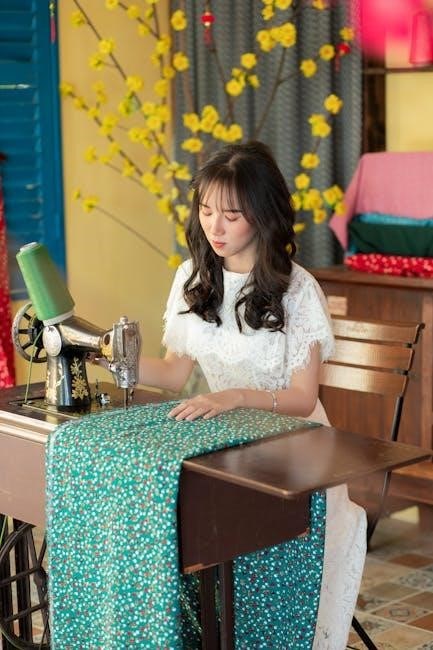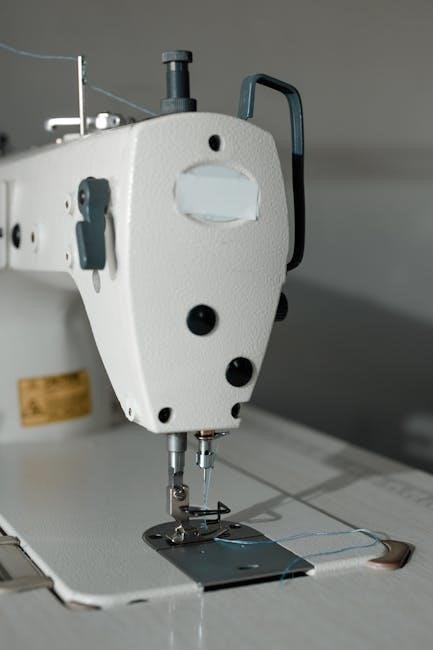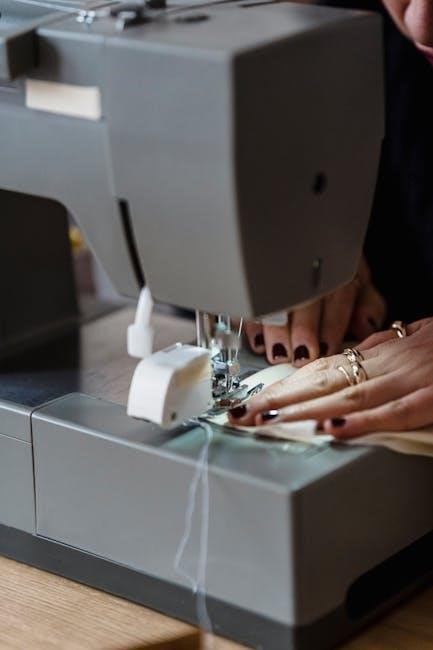Sewing machine cabinets are custom storage solutions designed to organize sewing supplies and protect machines. They offer foldable tops‚ adjustable lifts‚ and stylish designs to enhance sewing experiences.
What are Sewing Machine Cabinets?
Sewing machine cabinets are specialized storage units designed to house sewing machines‚ accessories‚ and supplies. They often feature foldable tops‚ adjustable lifts‚ and compartments for organization. These cabinets are typically made of wood or durable materials‚ offering a practical and stylish way to protect sewing equipment. Many designs include casters for portability and customizable features like shelves or drawers. They are ideal for sewing enthusiasts seeking to maximize space and keep their workspace tidy. Cabinets can be pre-made or custom-built using plans‚ catering to various sewing needs and room sizes.
Importance of Using a Sewing Cabinet
Using a sewing cabinet is essential for protecting your sewing machine and organizing supplies. It provides a dedicated workspace‚ keeping your machine dust-free and secure. Cabinets with foldable tops or adjustable lifts enhance convenience‚ allowing seamless transitions between tasks. They also save space‚ making them ideal for small rooms or apartments. Portability features like casters enable easy repositioning‚ while customizable storage compartments ensure everything is within reach. A sewing cabinet not only prolongs the life of your machine but also streamlines your workflow‚ making sewing more efficient and enjoyable. It’s a practical investment for any sewing enthusiast.
Benefits of Building Your Own Sewing Cabinet
Building your own sewing cabinet offers customization‚ cost savings‚ and space efficiency. It allows you to tailor the design to your needs‚ ensuring optimal functionality and style.
Space Efficiency and Organization
Building a custom sewing cabinet maximizes space by fitting your specific room dimensions. Foldable tops and adjustable shelves optimize storage‚ keeping supplies neatly organized. compartments and drawers store threads‚ fabrics‚ and tools‚ ensuring everything is within reach. Compact designs‚ like corner cabinets‚ utilize often-wasted areas. Mobility features‚ such as casters‚ allow easy repositioning. A well-planned cabinet enhances workflow‚ reducing clutter and saving time. Consider measuring your sewing area and machine size to tailor the design for seamless integration. This approach ensures a practical‚ efficient‚ and visually appealing sewing workspace.
Cost-Effectiveness
Building your own sewing cabinet can save money compared to buying pre-made options. Using affordable materials like plywood and basic hardware reduces costs. DIY plans often include detailed lists‚ helping you avoid expensive mistakes. You can customize the project to fit your budget‚ choosing cost-effective finishes or repurposing old furniture. Additionally‚ online resources offer free or low-cost plans‚ further cutting expenses. This approach allows you to create a functional and stylish cabinet without overspending‚ making it a budget-friendly solution for organizing your sewing space. It’s a practical way to enhance your hobby while saving money.
Customization Options
When building your own sewing cabinet‚ customization options are limitless. You can tailor the design to fit your specific needs‚ choosing materials‚ colors‚ and finishes that match your sewing room decor. Add decorative trim‚ paint‚ or stain to give it a personal touch. Incorporate adjustable shelves‚ drawers‚ or compartments to store supplies like threads‚ fabrics‚ and notions. Some plans even allow for advanced features like built-in lighting or electrical outlets. Personalized storage solutions ensure everything has its place‚ making your sewing sessions more efficient and enjoyable. This flexibility makes a DIY cabinet truly unique to your preferences and sewing habits.
Key Features to Consider in Sewing Cabinet Plans
When selecting sewing cabinet plans‚ prioritize features like size‚ portability‚ and storage options. Ensure the design accommodates your machine’s dimensions and includes compartments for supplies.
Size and Portability
When designing or selecting a sewing machine cabinet‚ size and portability are crucial considerations. Measure your workspace and sewing machine to ensure the cabinet fits seamlessly. Compact designs are ideal for small rooms or apartments‚ while larger models offer ample storage. Look for plans that include foldable tops‚ providing a generous work surface when open and a sleek profile when closed. Portability features like locking casters or handles allow easy movement‚ making it convenient to reposition the cabinet for better access to natural light or workspace optimization. Ensure the plan balances functionality with your spatial needs.
Storage Compartments
Storage compartments are essential for keeping sewing supplies organized and within reach. Look for plans that include shelves‚ drawers‚ and compartments tailored to your needs. Open shelves are great for frequently used items‚ while drawers provide hidden storage for valuable tools. Some designs feature adjustable shelves‚ allowing you to customize the space for different-sized supplies. Consider adding small trays or compartments for notions like buttons‚ threads‚ and needles. A well-designed storage system ensures your sewing area remains clutter-free‚ making your projects easier and more enjoyable. Optimize your cabinet with compartments that suit your sewing habits and material preferences.
Durability and Material Choice
Durability and material choice are crucial for a long-lasting sewing cabinet; High-quality wood‚ such as plywood or medium-density fiberboard (MDF)‚ ensures stability and strength. Solid hardwoods like oak or maple are excellent for heavy-duty use. Metal frames or reinforced joints add extra durability‚ especially for large machines. Consider water-resistant finishes like polyurethane to protect against spills. Proper material selection ensures your cabinet withstands frequent use and supports the weight of your sewing machine. Durable materials also enhance the aesthetic appeal‚ making your cabinet a lasting addition to your sewing space.

Choosing the Right Plan
Selecting the right sewing cabinet plan ensures your project meets your needs and skill level. Consider space‚ machine size‚ and desired features to find the perfect design.
Factors to Consider
When choosing a sewing cabinet plan‚ consider your machine size‚ workspace needs‚ and budget. Ensure the design fits your room layout and skill level. Check for features like adjustable shelves‚ foldable tops‚ and portability. Material durability and assembly complexity are crucial. Optional features such as built-in lighting or electrical outlets can enhance functionality. Compare plans from trusted sources like Rockler or DIY tutorials to find one that balances aesthetics and practicality. Ensure the plan includes clear instructions and a detailed materials list for a successful project.
Popular Types of Cabinets
Popular sewing machine cabinets include compact designs for small spaces‚ foldable top models‚ and drop-in sewing tables. Shaker-style cabinets offer timeless aesthetics‚ while lift-equipped cabinets provide ergonomic benefits. Corner units maximize space‚ and portable designs feature casters for easy mobility. Some plans incorporate interchangeable inserts for different machine sizes‚ ensuring versatility. These styles cater to various sewing needs‚ from hobbyists to professionals‚ offering a blend of functionality‚ durability‚ and personalized storage solutions to enhance sewing experiences.
Difficulty Levels
Sewing machine cabinet plans vary in difficulty‚ catering to different skill levels. Basic plans are ideal for beginners‚ requiring minimal tools and simple techniques. Intermediate designs incorporate features like adjustable shelves or foldable tops‚ while advanced plans include complex joinery or ergonomic lifts. Many PDF guides offer step-by-step instructions‚ making them accessible to novices. Experienced woodworkers can tackle intricate designs with confidence. Resources like video tutorials and online forums further assist builders‚ ensuring projects are manageable regardless of skill level.
Materials and Tools Needed
Essential materials include plywood‚ MDF‚ or solid wood‚ screws‚ hinges‚ drawer slides‚ and sandpaper. Tools needed are power saws‚ drills‚ sanders‚ and measuring tape for precise cuts.
List of Materials
To build a sewing machine cabinet‚ you’ll need high-quality materials such as plywood‚ MDF‚ or solid wood for the structure. Hardware includes hinges‚ drawer slides‚ and screws. Sandpaper and wood glue are essential for finishing. Additional materials like decorative trim‚ paint‚ or stains can enhance the design. For advanced features‚ consider adding lighting fixtures or electrical outlets. Ensure all materials are durable and suitable for the intended use. Proper measurements and cuts are crucial for a professional finish.
Essential Tools

Building a sewing machine cabinet requires a set of essential tools‚ including a circular saw‚ drill press‚ and hand saw for precise cuts. Measuring tools like a tape measure and square ensure accuracy. Sandpaper and orbital sanders are crucial for smoothing surfaces. Clamps and vises help hold pieces in place during assembly. Safety gear‚ such as safety glasses and a dust mask‚ is vital for protection. Additional tools like a router or jigsaw can be useful for decorative edges or complex cuts. Having the right tools ensures a professional finish and makes the project more manageable.

Step-by-Step Assembly Guide
Cutting panels‚ assembling frames‚ and attaching tops are key steps. Use machine screws for secure connections and add triangular gussets for stability. Follow detailed plans for success.
Preparing the Workspace
Creating a well-organized workspace is crucial for assembling a sewing machine cabinet. Start by clearing a large‚ flat area and cover it with a durable work surface‚ such as plywood or a workbench mat. Gather all tools and materials‚ ensuring they are within easy reach. Use clamps to secure panels during assembly and maintain proper ventilation when sanding or applying finishes. Protect your floor with drop cloths or plastic sheets to prevent damage from dust or spills. A tidy workspace enhances safety and efficiency‚ allowing you to focus on precise cuts and alignments.
Cutting and Measuring
Accurate cutting and measuring are essential for building a sewing machine cabinet. Use a high-quality circular saw or jigsaw for precise cuts‚ ensuring smooth edges. Measure twice before cutting to avoid errors. Mark all pieces clearly with labels and notes for easy identification. Consider using a miter saw for angled cuts and sand edges immediately after cutting to prevent splintering. Double-check measurements against your plan to maintain consistency. Proper cutting ensures a sturdy and professional-looking cabinet‚ while minimizing waste and saving time during assembly.
Assembly Process
Begin by assembling the base and side panels using wood screws and clamps. Ensure all corners are flush and secure. Attach the back and bottom panels next‚ reinforcing with triangular gussets for added stability. Once the base is sturdy‚ align the top panel and attach it using flathead machine screws. Install any swing-out panels or adjustable shelves according to your plan. Double-check alignment and tighten all joints firmly. Sand any rough edges before moving on to finishing. Proper assembly ensures a durable and functional cabinet‚ ready for your sewing machine and supplies.
Sanding and Finishing
After assembling the cabinet‚ sand all surfaces to smooth out rough edges and splinters. Start with medium-grit sandpaper‚ then switch to fine-grit for a polished finish. Wipe away dust with a tack cloth. Apply your preferred finish‚ such as paint‚ stain‚ or a clear sealant‚ following the manufacturer’s instructions. Allow each coat to dry completely before applying additional layers. For added protection‚ consider a water-resistant finish. Once dry‚ install hardware like knobs or handles. Sanding and finishing ensure a professional look and long-lasting durability‚ making your sewing cabinet both functional and visually appealing.

Advanced Features to Include
Enhance your sewing cabinet with adjustable shelves‚ built-in lighting‚ and electrical outlets for convenience. Consider a retractable lift for easy machine access‚ improving visibility and workflow efficiency.
Adjustable Shelves
Adjustable shelves are a key feature in sewing machine cabinets‚ offering versatility and customization. They allow you to tailor the storage space to fit your specific needs‚ ensuring your sewing supplies are neatly organized. With adjustable shelves‚ you can accommodate sewing machines of various sizes‚ threads‚ fabrics‚ and accessories. This feature ensures optimal use of space and easy access to your tools. Many plans include instructions for installing adjustable shelves‚ making it easier to adapt the cabinet to your workflow. This customization enhances productivity and keeps your sewing area tidy and efficient.
Built-in Lighting
Built-in lighting is an essential feature in sewing machine cabinets‚ providing optimal illumination for sewing tasks. It reduces eye strain and enhances visibility‚ especially when working with intricate patterns or small details. Many plans include LED lighting options that are energy-efficient and adjustable‚ allowing you to customize the brightness. Strategically placed lights ensure even coverage across the work surface‚ making it easier to see stitches‚ threads‚ and fabric. This feature is particularly useful in low-light environments and adds comfort during long sewing sessions. Incorporating built-in lighting into your cabinet design ensures a well-lit‚ efficient workspace tailored to your sewing needs.
Electrical Outlets
Electrical outlets integrated into sewing machine cabinets offer convenience and functionality. They provide easy access to power for sewing machines‚ irons‚ and other tools‚ reducing cord clutter. Many PDF plans include outlets with USB ports‚ catering to modern devices. These outlets are strategically placed to keep cords organized and within reach. Safety features like surge protection are often recommended to safeguard equipment. Adding electrical outlets enhances workflow efficiency‚ making your sewing space more practical and user-friendly. This feature is especially valuable for crafters who use multiple gadgets simultaneously‚ ensuring a seamless and organized workspace tailored to their needs.

Customization Ideas
Customize your sewing cabinet with paint‚ finishes‚ and decorative trim to match your style. Add personalized storage solutions for optimal organization and functionality‚ enhancing your sewing experience.
Paint and Finish Options
Customize your sewing cabinet with various paint and finish options to match your home decor. Choose from latex‚ chalk‚ or stain finishes for a personalized look. Apply polyurethane for durability or opt for a distressed finish for a vintage vibe. Consider matching the color to your sewing room or adding a bold accent. Proper preparation‚ including sanding and priming‚ ensures a professional result. Experiment with different techniques like layering or glazing to create unique effects. The finish not only enhances aesthetics but also protects the wood‚ ensuring your cabinet remains functional and beautiful for years.
Adding Decorative Trim
Add a personal touch to your sewing cabinet with decorative trim‚ enhancing its elegance and style. Choose from a variety of materials like wood‚ metal‚ or PVC‚ and styles such as carved‚ routed‚ or appliqué designs. Measure the edges or surfaces where the trim will be applied and secure it using adhesive‚ nails‚ or screws. This detail complements the cabinet’s design and adds visual interest; Select a trim that matches your sewing room’s aesthetic for a cohesive look‚ making your DIY project truly unique and reflective of your personal taste.
Personalized Storage Solutions
Maximize your sewing cabinet’s functionality with personalized storage solutions tailored to your needs. Incorporate adjustable shelves‚ compartments‚ and drawers to organize fabrics‚ threads‚ and tools. Consider adding inserts or dividers to keep small items like buttons and needles tidy. Customize the layout based on your sewing habits and machine size‚ ensuring easy access to essentials. This tailored approach enhances efficiency‚ reducing clutter and saving time. By designing storage spaces specific to your requirements‚ you create a seamless workflow‚ making your sewing experience more enjoyable and productive.

Budget Considerations
Plan your budget by estimating material costs‚ tools‚ and optional features. Compare DIY projects with pre-made cabinets to find cost-effective solutions that meet your sewing needs.
Estimating Costs
Estimating costs involves calculating materials‚ tools‚ and labor. Materials like plywood‚ MDF‚ and hardware can range from $50 to $200. Tools and plans may add $20 to $100. Labor costs vary if hiring help. Optional features like lifts or lighting can increase expenses. Consider the complexity of the design and the quality of materials. DIY projects often save money compared to pre-made cabinets. Budgeting carefully ensures your sewing cabinet fits both your needs and finances. Compare prices and plans to optimize your spending effectively.
Saving Money Tips
Recycle materials like old furniture or pallets to reduce costs. Shop for hardware and lumber during sales or use coupons. Opt for simpler designs to minimize expenses. Avoid expensive finishes or decorative elements unless necessary. Consider free or low-cost PDF plans online. Consider the cost of optional features like lifts or lighting and prioritize based on your budget. Buying materials in bulk or second-hand can also lower expenses. Plan carefully to avoid waste and ensure materials are used efficiently. DIY projects often save money compared to pre-made cabinets‚ so take advantage of resources and tools you already own.
Comparing to Pre-Made Cabinets
Building your own sewing cabinet using PDF plans often costs less than buying pre-made cabinets. DIY projects allow customization to fit specific needs and spaces‚ whereas pre-made options may lack flexibility. Pre-made cabinets can be expensive and may not offer the exact features desired. DIY plans enable you to choose materials and designs tailored to your budget and preferences. Additionally‚ DIY projects can be completed at your own pace‚ and repairs or modifications are easier. Overall‚ DIY sewing cabinets provide cost savings‚ personalization‚ and long-term satisfaction compared to pre-made alternatives.
Safety Precautions
Always wear protective gear and ensure a stable workspace. Follow power tool guidelines and handle materials carefully to avoid injuries. Prioritize safety throughout the building process.
Handling Power Tools Safely
When working with power tools‚ wear safety glasses and ensure loose clothing is secured. Keep tools well-maintained and follow manufacturer instructions. Avoid overreaching and maintain a firm grip. Unplug tools during breaks and store them safely. Proper ventilation is crucial when using materials like plywood or MDF. Always handle sharp objects with care and keep children away. Regularly inspect cords for damage. Stay alert and avoid using tools when fatigued; These precautions ensure a safer environment for building your sewing cabinet. Prioritize safety to prevent accidents and enjoy a successful project.
Protecting from Dust
Protecting your workspace and materials from dust is essential when building a sewing cabinet. Always use proper ventilation‚ especially when cutting materials like plywood or MDF. Wear a dust mask to avoid inhaling particles. Cover your work area with drop cloths or plastic sheets to prevent dust from settling on surfaces. Regularly clean tools and ensure they are free from debris. Use a vacuum with a HEPA filter to minimize airborne particles. Sealing wood surfaces with finishes can also help reduce dust over time. Keeping your workspace clean ensures better results and prolongs the life of your sewing cabinet.
Ensuring Stability
Stability is crucial for a sewing cabinet to prevent wobbling and ensure safe operation. Use sturdy materials like solid wood or thick plywood for the base. Install adjustable legs or leveling feet to balance the cabinet on uneven floors. Reinforce corners with triangular gussets or brackets for added strength. Avoid overloading the cabinet with excessive weight. Test the stability before use by gently rocking the cabinet. Proper assembly and alignment of all parts ensure a stable structure. A stable cabinet provides a secure workspace for sewing‚ reducing the risk of accidents and improving overall functionality.

Resources and Tutorials
Find detailed sewing machine cabinet plans in PDF format online. Websites offer step-by-step guides‚ exploded views‚ and materials lists for DIY projects. Rockler and Etsy provide excellent resources.

Where to Find Plans
Discover a wide range of sewing machine cabinet plans in PDF format online. Websites like Rockler and Etsy offer detailed blueprints with step-by-step instructions and materials lists. DIY forums and crafting communities‚ such as Pinterest and Reddit‚ feature user-shared plans and tutorials. Many plans include photos‚ exploded views‚ and customizable options to suit different skill levels and spaces. These resources provide everything needed to create functional and stylish sewing cabinets‚ catering to both beginners and experienced woodworkers.
Video Guides
Enhance your DIY project with video guides available on platforms like YouTube and crafting websites. These tutorials provide visual step-by-step instructions‚ covering topics from cutting materials to assembly. Many videos demonstrate how to incorporate features like adjustable shelves and built-in lighting. They also offer tips for customizing your sewing cabinet to fit your workspace. Whether you’re a novice or an experienced maker‚ these guides help ensure a smooth and successful build‚ making your sewing cabinet project both enjoyable and professional-looking.
Online Communities

Online communities are invaluable resources for DIY sewing cabinet projects. Platforms like Pinterest‚ Reddit‚ and specialized sewing forums offer inspiration‚ tips‚ and support. Members share their experiences‚ showcasing completed projects and offering advice. These communities are great for troubleshooting common issues or finding unique customization ideas. Many users also share free or paid PDF plans‚ making it easier to find the perfect design for your needs. Engaging with these groups can enhance your creativity and ensure your sewing cabinet turns out both functional and stylish.
Building a sewing machine cabinet offers space efficiency‚ customization‚ and cost savings. Start with a clear plan‚ measure carefully‚ and enjoy the satisfaction of creating a functional‚ stylish workspace.
Building a sewing machine cabinet provides numerous advantages‚ including space-saving design‚ protection for your machine‚ and organized storage for supplies. Customization options allow tailored solutions to fit specific needs‚ while cost-effective materials ensure affordability. These cabinets enhance workspace efficiency‚ offering a dedicated area for sewing projects. Durable construction ensures long-lasting use‚ and stylish designs complement home décor. Whether for hobbyists or professionals‚ sewing machine cabinets are a practical and functional investment‚ combining functionality with personal style to create an ideal sewing environment.
Encouragement to Start
Embarking on a DIY sewing machine cabinet project is an exciting and rewarding endeavor. With detailed PDF plans‚ you can create a custom storage solution tailored to your needs. Not only will you save money‚ but you’ll also gain a sense of accomplishment from crafting something functional and stylish. These plans are designed to guide you through every step‚ making it accessible even for beginners. Start your project today and enjoy the satisfaction of organizing your sewing space with a beautiful‚ handmade cabinet that enhances your creativity and workspace efficiency.
Final Tips for Success
When building your sewing machine cabinet‚ prioritize precision in measurements and cuts for a professional finish. Use high-quality materials to ensure durability and stability. Consider adding adjustable features like shelves and lighting to maximize functionality. Don’t hesitate to customize the design to fit your sewing room’s aesthetic. Follow the PDF plans carefully‚ and take your time during assembly. Safety is key—always handle power tools with care and work in a well-ventilated area. With patience and attention to detail‚ you’ll create a beautiful‚ functional cabinet that enhances your sewing experience and keeps your supplies organized for years to come.
